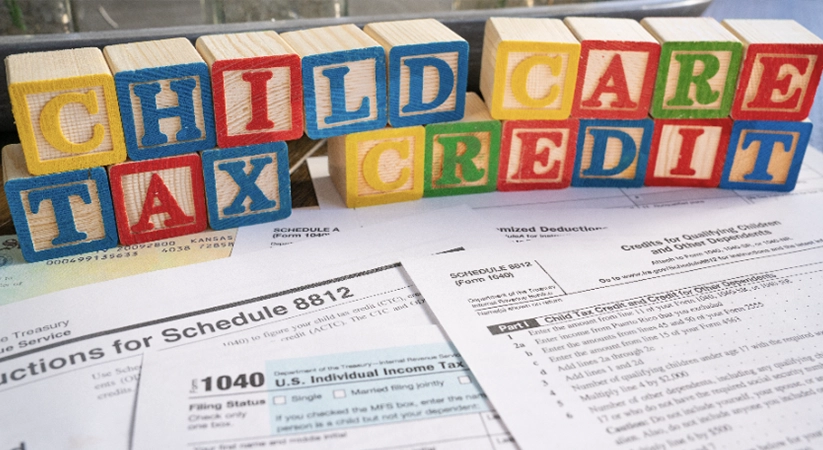
One more reason to love those adorable bundles of tax breaks.
The non-refundable Child and Dependent Care Tax Credit is designed to ease the financial burden of working families who need to pay for the care of qualifying persons, such as children or disabled dependents, in order to be able to work. This credit serves as a federal tax benefit that can help reduce the amount of federal income tax owed on a tax return.
To be eligible for this credit, taxpayers must meet certain requirements, including the need for care due to employment or job seeking, the provision of care by a qualified individual or facility, and the income and filing status requirements.
The credit is calculated as a percentage of qualifying expenses, which are capped at $3,000 for one qualifying person and $6,000 for two or more qualifying persons. The percentage of expenses covered by the credit depends on the taxpayer’s income level, with higher-income taxpayers receiving a lower percentage.
It’s important to note that this credit is non-refundable, meaning that it can only reduce the tax liability to zero, but any remaining credit cannot be refunded to the taxpayer. For working families, this credit can provide valuable tax savings and make child and dependent care more affordable, but it is important to carefully consider the requirements and limitations before claiming the credit on a tax form.
Are You Eligible for the Child Care Tax Credit?
The Child Care Tax Credit provides financial assistance to working parents or guardians who need to pay for child care services. To qualify for this credit, certain eligibility requirements must be met. The taxpayer must have earned income and incurred work-related expenses for child care. The child for whom care is provided must be under the age of 13 unless they are physically or mentally unable to care for themselves. Additionally, the child must be a dependent of the taxpayer and live with them for more than half of the year. The care must be provided by an eligible individual or facility, and the taxpayer cannot claim expenses paid to a spouse or dependent. Lastly, the taxpayer must meet income and filing status requirements, which vary depending on their situation.
Meeting all of these eligibility requirements can lead to significant tax savings for working parents and guardians.
Qualifying for the Child Care Tax Credit Is Easy (to Figure out)
To be eligible for the Child Care Tax Credit, the dependent person must be under the age of 13 or unable to care for themselves due to a mental or physical disability. In addition, the person you are caring for must be your child, stepchild, foster child, sibling, or another dependent who has lived with you for at least six months out of the year.
To qualify for this credit, your dependent person must also be a U.S. citizen, resident, or national. Furthermore, you must be providing over half of their financial support.
Finally, to claim this credit, there is an income threshold that must be met. For a single parent or married filing separately, the adjusted gross income must be less than $75,000. For those filing a joint tax return, the income threshold is set at $150,000.
Income Level Requirements
To be eligible for the Child Care Tax Credit, income level is an important factor to consider. The credit is designed to assist working parents and caregivers with child care expenses by granting a percentage of eligible expenses as a federal tax benefit.
According to the IRS, the income requirements for the credit depend on the filer’s taxable income. For a single parent or those filing separately, the adjusted gross income must be less than $75,000. For those who are married and filing jointly, the threshold is set at $150,000.
Additionally, the amount of the credit decreases as income increases. The credit covers up to 35% of eligible expenses for filers who earn $15,000 or less, but this percentage shrinks as income rises. The maximum percentage of expenses covered by the credit is 20% for taxpayers who earn $43,000 or more.
Other Factors that Affect Eligibility
Other factors that affect eligibility for the Child Care Tax Credit include the age of the dependent and whether they can care for themselves. For example, children under the age of 13 may qualify for the credit if they require care while their parent or guardian is at work. Similarly, individuals of any age who are physically or mentally unable to care for themselves may also qualify for the credit.
The amount paid for dependent care is another important consideration for eligibility. The credit is typically calculated as a percentage of the total expenses paid for child care, with a maximum credit of $3,000 for one child or $6,000 for two or more children.
Income levels also play a role in determining eligibility. As mentioned earlier, the credit is gradually reduced for taxpayers with higher incomes. In addition, there may be special provisions for divorced or separated parents, such as rules regarding which parent is eligible to claim the credit.
Required Documentation Needed to Claim a Dependent Care Benefit or Credit
To claim a dependent care benefit or credit, you need to provide certain documentation as per the IRS guidelines. The types of documentation required include receipts or statements from your care provider that outline the services provided, dates of service, and the amount of money paid. You may also need to provide proof of your income and employment, as well as verification of your dependent’s status.
It’s important to keep accurate records and maintain thorough documentation of your dependent care expenses. This will not only make it easier to claim the credit, but also assist in case of an IRS audit. You should also be aware of the different types of expenses that qualify for the credit, such as day care expenses for children under the age of 13, before and after school care costs, and summer day camp expenses.
By keeping careful documentation and understanding the qualified expenses, you can confidently claim the dependent care credit or benefit and receive the maximum tax benefit possible.
Common Types of Qualified Daycare Expenses that May be Eligible For The Child Care Tax Credit
The Child Care Tax Credit is a valuable tax benefit that can provide significant relief to working families who pay for child care expenses. However, it’s important to understand what expenses qualify for the credit to make sure you’re getting the maximum benefit. In general, qualified expenses are those paid for the care of a child under the age of 13 while the parents or guardians are working or looking for work.
Types of Expenses Eligible for the Credit
The Child Care Tax Credit is a federal tax benefit that helps qualifying taxpayers offset the cost of child care expenses. To be eligible for the credit, you must have a qualifying child under age 13 or a dependent who is physically or mentally incapable of self-care.
The eligible expenses that can be claimed for the credit include in-home care, out-of-home care, and care provided by a dependent care center. In-home care expenses may include wages paid to a babysitter, nanny, or au pair, as well as related payroll taxes. Out-of-home care expenses may include the cost of day camp, nursery school, or other similar programs. Care provided by a dependent care center may include the cost of daycare centers, preschools, or other facilities.
It’s important to note that not all child care expenses are eligible for the credit. For example, expenses paid to a care provider who is your spouse, the parent of the qualifying child, or someone you can claim as a dependent on your tax return are not eligible. Additionally, expenses related to overnight camp, tutoring, or school-related activities are not eligible.
To qualify, the taxpayer or their spouse must have earned income during the year and the expenses must be incurred so that the taxpayer could work or look for work. The credit is based on a percentage of the taxpayer’s qualifying expenses and is subject to income limits.
Expenses that are ineligible for the child care tax credit
When considering whether to claim the child care tax credit, it’s important to know what expenses are not eligible for the credit. Be aware that transportation costs to and from childcare facilities, overnight camp expenses, costs for chauffeur or gardening services, expenses for education of a child in kindergarten or higher, and expenses for before- or after-school programs that are not solely for the care of the child are all ineligible for the credit.
Transportation costs, such as gas, repairs, and insurance, are not eligible for the credit even if they are incurred in order to take a child to a qualifying child care provider. Likewise, expenses related to overnight camps or non-work-related activities are not eligible. If an expense is related to education rather than solely for the purpose of childcare, it is also ineligible. This includes expenses for kindergarten and higher education, such as private school tuition or tutoring expenses.
Finally, expenses for before- or after-school programs that are not solely for the care of the child are also ineligible. For example, if a child attends a program for art or sports but receives childcare as part of that program, the child care expense may not be claimed for the credit.
Calculating Your Benefit Amount of the Child Care Tax Credit
Families with dependent children often need to pay for childcare services so that they can work or attend school. Fortunately, the government offers tax credits to help alleviate some of the financial burden. The Child Care Tax Credit is one such benefit that helps eligible families reduce their tax liability. However, calculating the exact benefit amount can be challenging, as there are many factors to consider.
How Much is the Child Care Tax Credit Worth in 2023?
In the year 2023, the child care tax credit will be worth up to $4,000 for one qualifying dependent or up to $8,000 for two or more qualifying dependents. This is an increase from the maximum benefit of $3,000 per dependent in previous years.
The child care tax credit is partially refundable, which means that even if a taxpayer does not owe any income tax, they may still be able to receive a portion of the credit as a refund. To claim the credit, taxpayers must fill out Schedule 8812 and attach it to their federal tax return.
The percentage of qualifying expenses covered by the credit is based on the taxpayer’s income level and ranges from 20% to 50%. There are also maximum benefit levels and limits. For example, the credit cannot exceed the taxpayer’s earned income or their total federal tax liability.
Amounts Allowed Per Qualifying Dependent
As per the IRS guidelines, the amounts allowed per qualifying dependent are limited to $3,000 for one qualifying individual or $6,000 for two or more qualifying individuals. The maximum limit is based on the number of qualifying individuals for whom the taxpayer paid childcare for, not the number of individuals who can claim the credit.
A qualifying dependent includes children under the age of 13, spouses who are physically or mentally incapable of self-care, or individuals who are incapable of self-care due to physical or mental defect. The funds received through the Child Care Tax Credit can be used to cover work-related expenses for the qualifying dependents, such as day camps, nursery schools, or after-school programs. However, the credit cannot be claimed for regular school expenses like tuition fees.
Maximum Benefit Levels and Limits
The maximum benefit level for the Child and Dependent Care Credit varies depending on the total expenses incurred and income level. For families with one qualifying dependent, the maximum benefit limit is $3,000 per year. Families with two or more qualifying dependents can claim up to $6,000 per year.
The percentage of expenses covered by the credit also varies based on income level. For families with an adjusted gross income of less than $15,000, the credit covers up to 35% of qualifying expenses. This percentage gradually decreases as income increases until it reaches 20% for families with an adjusted gross income of $43,000 or more.
It’s important to note that the number of qualifying dependents also affects the maximum benefit limit and the percentage of expenses covered. For example, a family with two children can claim up to $6,000 in qualifying expenses, but the credit will only cover a percentage of that amount based on their income level.
Percentage of Qualifying Expenses Covered by the Credit
The credit helps reduce the tax liability by allowing a percentage of qualifying expenses as a credit against the tax owed. The percentage of expenses covered by the credit depends on the taxpayer’s income level and the number of qualifying dependents.
It’s important to note that the credit only applies to qualified expenses, which are expenses that are incurred for the care of a qualifying person. The maximum amount of qualifying expenses that can be claimed depends on the number of qualifying dependents. Taxpayers may claim up to $3,000 of qualified expenses for one qualifying dependent or up to $6,000 for two or more qualifying dependents. Overall, the percentage of qualifying expenses covered by the credit provides valuable tax savings for eligible taxpayers, allowing them to pay for the necessary care their dependents require while working.
Claim the child and dependent care tax credit in 2023
Claiming the child tax credit can help reduce the amount of taxes you owe or increase your refund.
The child tax credit is worth up to $3,000 per eligible child ages 6 to 17 and up to $3,600 per eligible child under age 6.
To claim the credit, you must first determine if you are eligible and provide the necessary information on your tax return.
Four Steps to Apply for the Child and Dependent Care Tax Credit
- Determine eligibility: To be eligible for the Child Care Tax Credit, the taxpayer must have earned income for the year, live with the person(s) being cared for, and ensure that the care provider is not their spouse or claimed as a dependent.
- Gather required documentation: Applicants must provide documentation of their earned income, as well as receipts or statements from the care provider showing the amount paid for care.
- Calculate the credit: The credit is a percentage of the qualifying expenses, which include the cost of care for children under 13 years old or those with disabilities. The maximum qualifying expenses are $8,000 for one dependent and $16,000 for two or more dependents.
- File taxes appropriately: The Child Care Tax Credit is claimed on Form 2441, which should be attached to the taxpayer’s Form 1040 or 1040-SR. The credit is nonrefundable, meaning that it can only be used to offset taxes owed.
Filing Status Requirements for Claiming a Joint Return or Separate Returns
When applying for the Child Care Tax Credit, it’s important to understand the filing status requirements for claiming a joint return or separate returns. Married taxpayers have to file joint returns. Married couples filing separate returns may disqualify them from claiming this credit.
If a taxpayer’s dependent does not have a Social Security number, they may still be able to claim the credit by using an individual taxpayer identification number (ITIN) or adoption identification number (ATIN). However, the dependent must meet all other qualifications for the credit.
It’s important to note that if a taxpayer is married but cannot file a joint return due to certain circumstances, such as being separated or living apart, they may be able to file as “married filing separately” and still claim the Child Care Tax Credit. However, they will likely face lower income limits and a reduced credit amount.
Bottom line: Is it worth claiming the care tax credit?
Yes, it’s worth it for taxpayers who are paying for child care expenses in order to work or actively look for work. The Child and Dependent Care Tax Credit is a nonrefundable credit that can reduce a taxpayer’s tax bill by up to $1,050 for one qualifying dependent and up to $2,100 for two or more qualifying dependents. To be eligible, the taxpayer must have earned income and have paid for care for a qualifying person, such as a child under age 13, a spouse who is unable to care for themselves, or a parent who lives with the taxpayer and is unable to care for themselves.
While employer-sponsored dependent care flexible spending accounts (FSAs) can also provide tax savings on child care expenses, they have a use-it-or-lose-it provision and can only be funded up to $5,000 per year.
For taxpayers who have child care expenses that exceed $5,000 or who may not use up all their FSA funds, claiming the CDCC may be the more advantageous approach. However, taxpayers should consider their individual circumstances and consult with a tax professional to determine the best option for them. Claiming the CDCC may lower a taxpayer’s tax bill or result in a refund, making it a valuable tax credit for those who qualify.

Sarah Nieschalk
Sarah E. Deierlein Nieschalk, EA, is an experienced tax professional with over a decade of expertise representing taxpayers before the IRS. As an Enrolled Agent and Assistant Vice President of Servicing at Community Tax, LLC, Sarah specializes in resolving complex federal and state tax collection issues, including high-dollar individual liabilities, employment tax challenges, and corporate audits. Since becoming an Enrolled Agent in 2012, she has resolved over 5,000 cases, saving millions for clients while protecting countless businesses. Outside of work, Sarah enjoys painting, staying active, and raising her family of rescued dogs while contributing to nonprofit causes through storytelling events.







